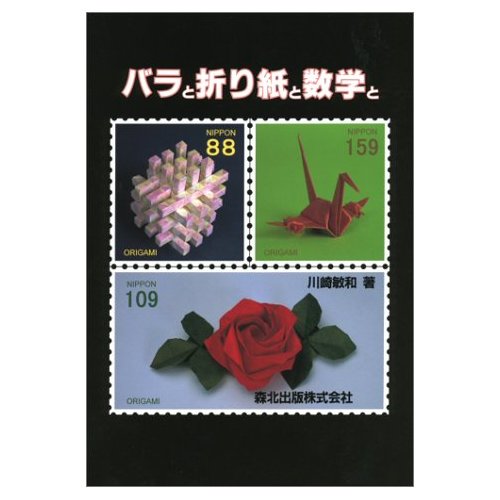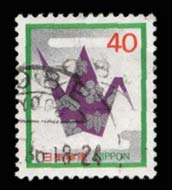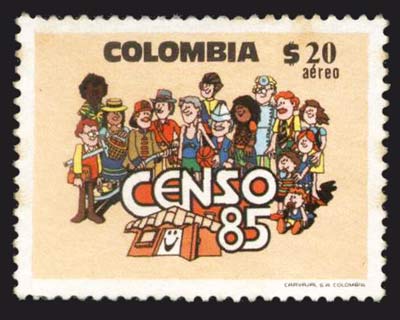Origami practitioner José Tomás Buitrago has loved and practiced the art of paper folding since childhood. He is interested in the history of origami as well as in the relationship between origami and mathematics. He is also a collector of postage stamps featuring origami themes!
Over the years, José has attended many international origami conventions. Since 1997 he has been one of the principal organizers of the origami convention in Cali, Colombia.
José and I spoke recently about his interest in collecting postage stamps related to origami.
What kind of stamps related to origami do you have in your collection and what criteria do you use to include them in it?
My approach is to look for stamps that show objects made with folded paper or other materials such as palm leaves. I also include any stamp that features origami-related people, or those which have a design that looks like something that has been folded. For example: Pictures of folded paper, or artwork with folded letters.
Many stamps showing folded figures were not issued with the intention to have origami as the subject but they are about other themes. Origami pieces has been featured in stamps about Christmas, children’s games, children’s stories or anniversaries of post offices.
If we compare this categorization with other collections of thematic philately there are not many stamps related to the topic of origami. An important fact is that the most frequent origami figures appearing on stamps are of the traditional paper plane, the origami crane and the traditional paper boat. Also in that order.
What prompted you to start collecting these stamps?
When I started folding paper, I took up philately again and decided to join the two hobbies. On the side of philately, people don’t know much about the topic of origami. On the side of origami, nobody I knew engaged in stamp collecting. So I found it to be a good fusion of these two disciplines.
I was motivated in part when I saw the cover of the Japanese version of Roses, Origami & Math, a book by Kawasaki. The stamps shown on it are ideal but they were made only for the cover of the book.
As for actual stamps, in the book Complete Origami (E. Kenneway) and ORU Magazine 16 there are references. These were the first sources I searched through. I then brought up the topic in the Origami Mailing List and there were some answers that filled out my database.
What was the first origami-related postal stamp in your collection?
I’m not sure. but I would say that the first origami-related stamp I ever saw was one from Japan in 1989 with an illustration of an unopened origami crane. This design, categorized as celebratory, was used in Japan to issue six stamps in different years and with different face values.
How do you find these stamps?
There are various ways. One is using the Internet to search for keywords such as: stamp, origami, paper airplane and so on. I do it in many languages, but mostly in English. With the online translators I have done searches in German, Italian and even Japanese and Chinese. Over time I’ve learned the word for “stamp” in 10 languages! I have a few pages where I always search and I have been able to identify many stamps.
The next step is to go to places that sell stamps. In Colombia there are very few places that do so. At those few places I frequent though, I have to ask the clerk to show me the stamps they have, and usually they don’t think there are stamps in this topic. I have never bought stamps online, only in person.
What challenges do you face for your collection?
The issue is to be able to find the actual stamps, and mainly those most recent issues from 1990 until now. Another challenge is that the stamps of some countries are difficult to obtain. Sometimes, I want only one stamp from a set, but I have to buy the whole set in order to obtain that one stamp.
In addition to the postage stamps there are miniature sheets, souvenir sheets, Maximum cards, First Day Covers (FDC), special postmarks, and postal stationery with postmarks. It is a challenge as many are not easily obtainable.
Very few sellers are receptive to my way of searching for stamps. Many do not show them to me because they say their time is more valuable than any stamps I might buy. If I don’t find stamps their attitude is worse. Only once a salesman, who is also a philatelist, stayed two hours beyond the shop’s closing time while I looked for stamps.
What is your favorite stamp in the collection? Why?
I don’t have favorites, but I would mention one of Colombia (Census 85), showing a bricklayer wearing a paper hat. The older the stamp the more I like it. And I have some stamps from countries that no longer exist, such as Czechoslovakia.
What stamp has been most difficult to find?
This is another interesting point! The ones I have have been easy to find. The challenge is to see how I could find those that I don’t have yet.
How many stamps do you have in your collection?
I have not counted them, but I think that more than 200. I have identified at least 800.
What stamp in your collection do you consider a treasure, not only in terms of price, but aesthetically and for its rarity?
I do not concern myself too much with the monetary value of individual stamps. I think the entire collection is a treasure because of the joining of the two themes, origami and philately.
How do you see your collection into the future? Do you have any plans to exhibit?
I see the collection with all the stamps that I have identified. Any exhibition must be done following the guidelines of thematic philately. At the moment though, I’m missing some key stamps in order to start organizing such an exhibition.
If someone wants to send you a postage stamp related to the topic of origami how would they contact you?
They can contact me by email jtbm71@gmail.com and we can make arrangements. Usually I send people a picture of the stamp to make their search easier. They must visit a stamp dealer if the stamp is older than two years.








Hello Leyla! My nephew, who is a second-grader this year, has recently become interested in stamp collecting as I was told by his father, my brother. Naturally when I heard about his interest, I forwarded this most interesting and informative article and am happy for the opportunity to share it with them! I will also send a few of my stamps to him enclosed in the Gift Origami Envelope from your recent video! What perfect timing and harmony! As usual, Origami Spirit is the embodiment of its name. We thank you, Leyla.
Stamp collecting is such a beautiful hobby for a child to take up! Thank you Sharon for sharing the story about your nephew with us.
Great post. Leyla! I also have a small collection of origami on stamps. I maintain a list (with photos) of stamps and other philatelic material with origami that I know of on http://www.giladorigami.com/Articles-Stamps-Origami.html, and José Tomás did help me with some information. The American Topical Association used this list to make their own version. Only from the picture you posted I find that I have some more to add! Good hunting, José! :-)
Hi Gilad,
Thank you for sharing the link to your site and your wonderful collection of origami-related stamps. I wish you good luck finding those missing stamps and l look forward to seeing them on your page!
What an intersting article! I really like it that there are so many ways to occupy yourself with origami! I wish José lots of succes in finding more origami stamps. I’m sure going to look out for it!
Thank you Danielle!